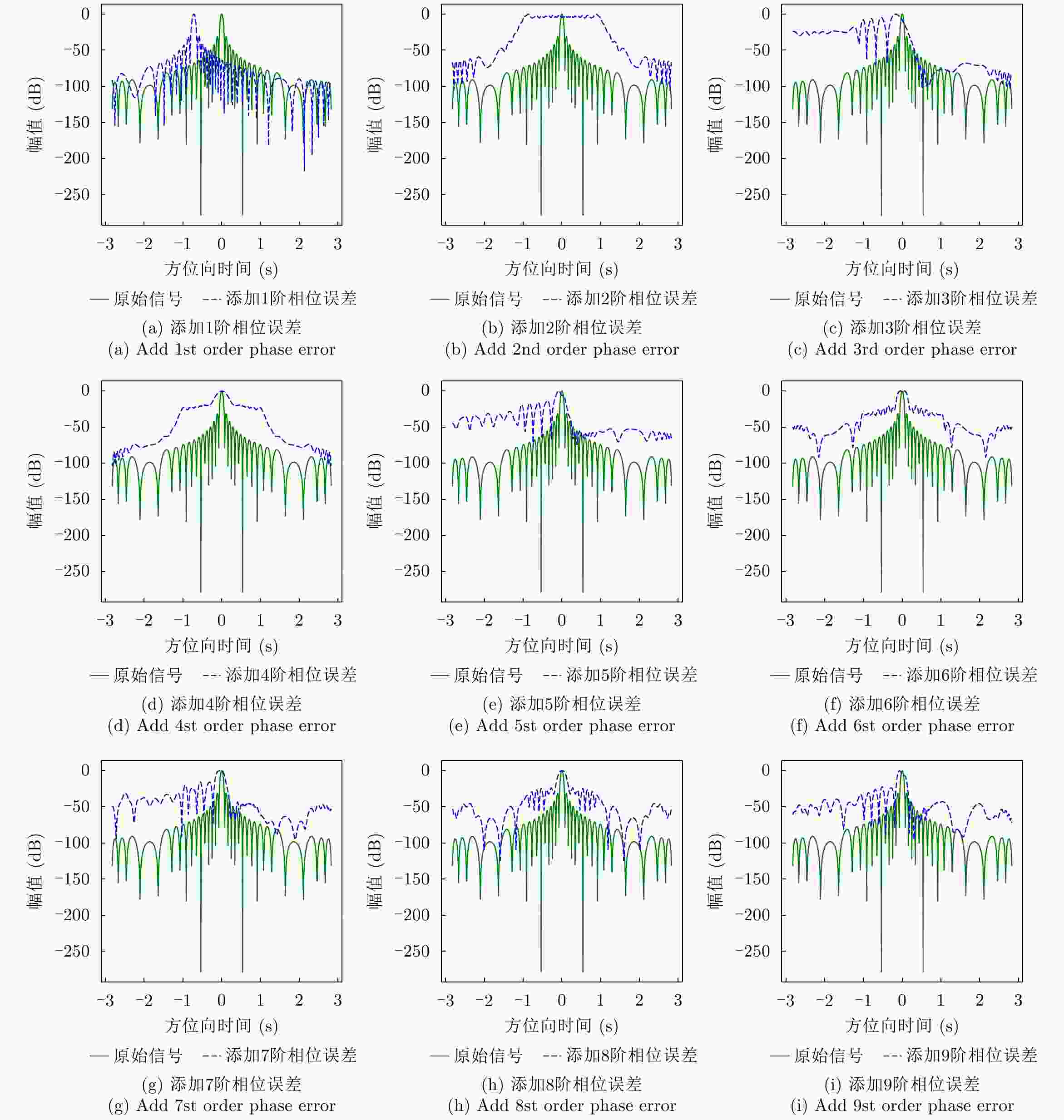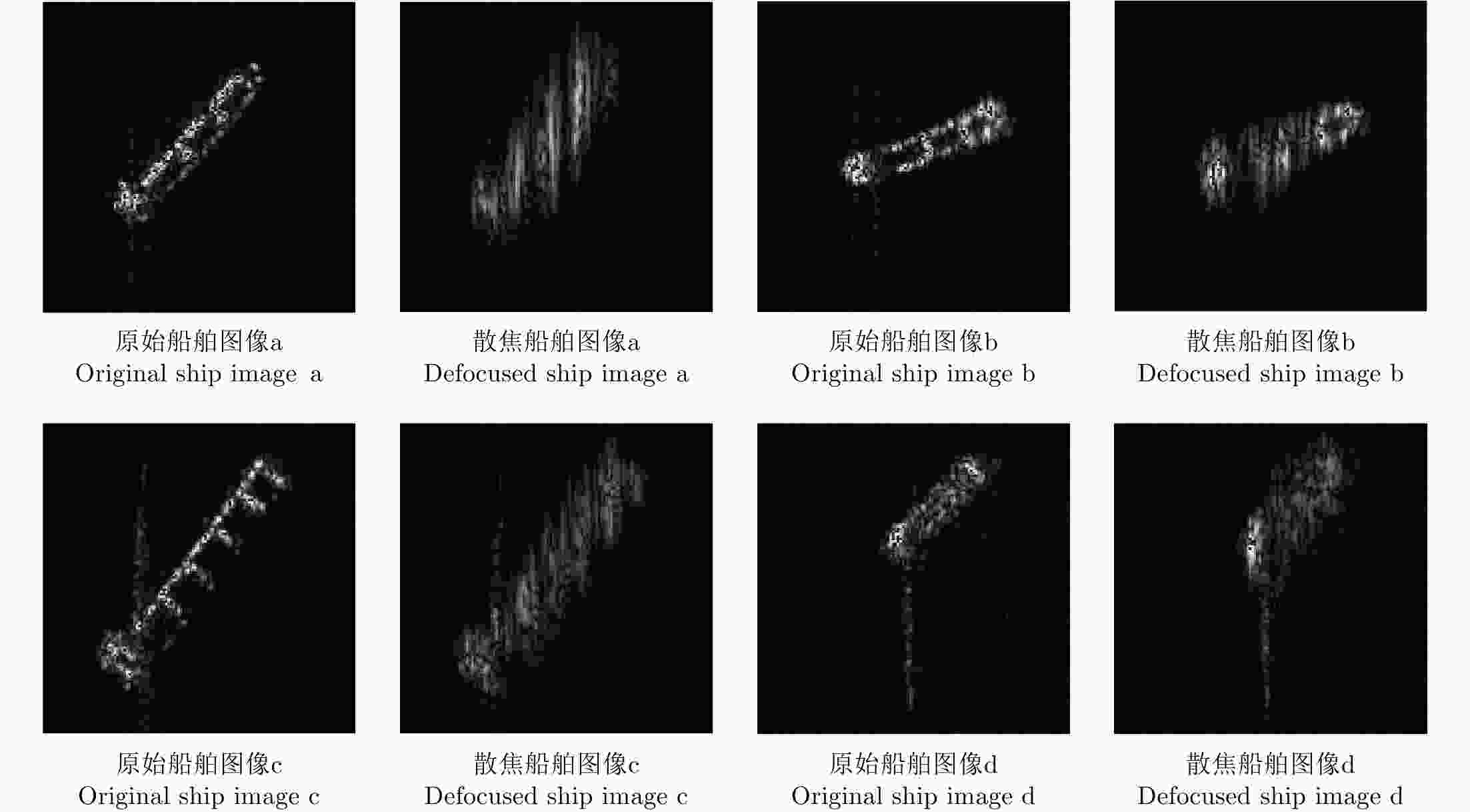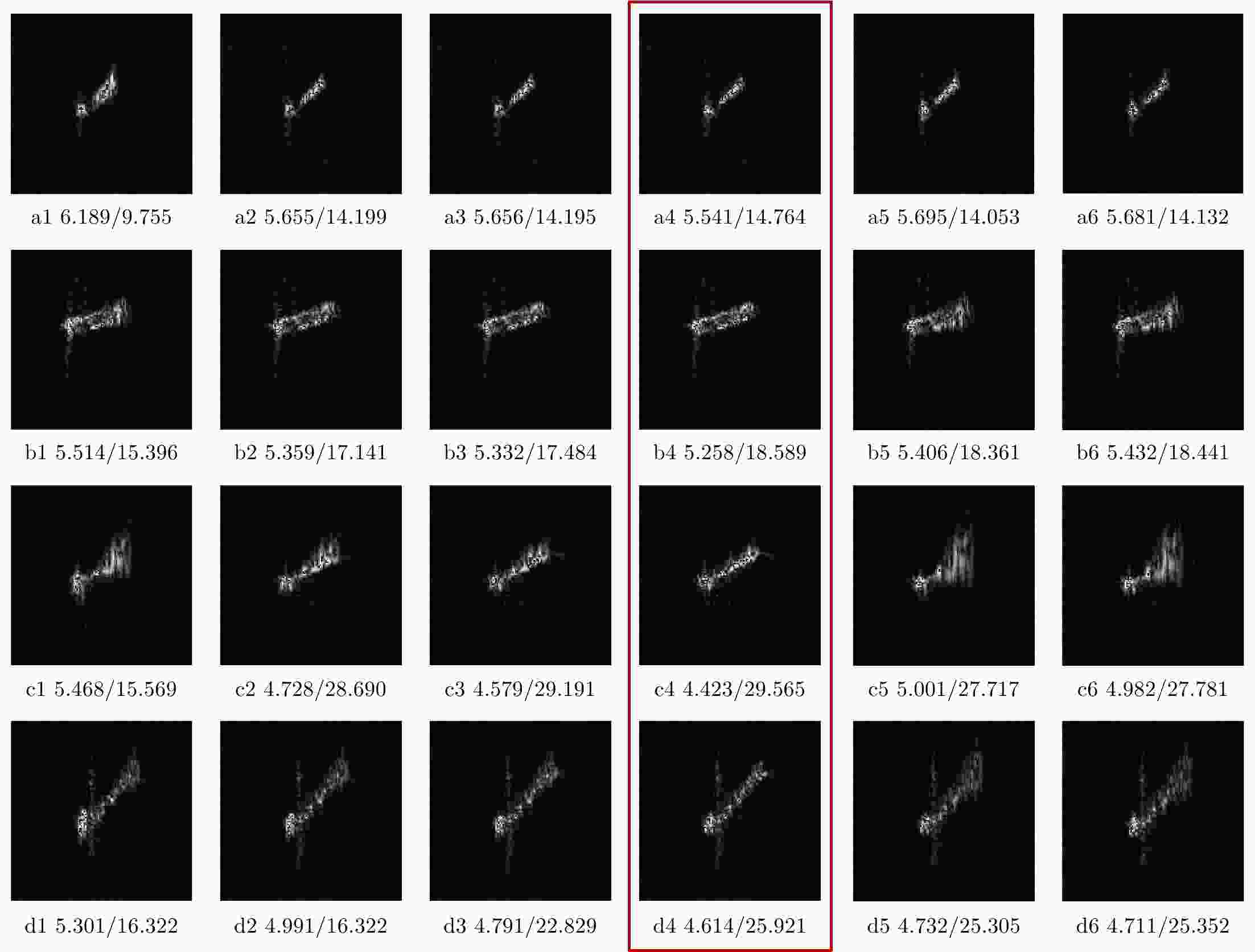A Novel Autofocus Algorithm for Ship Targets in SAR Images Based on the Adaptive Momentum Estimation Optimizer and Space-variant Minimum Entropy Criteria
-
摘要: 在SAR散焦船舶图像中,部分船舶目标的散焦现象具有沿距离向空变的特性。针对此类散焦船舶目标,该文提出了一种基于自适应动量估计优化器与空变最小熵准则的SAR图像船舶目标自聚焦算法,该算法直接对复图像进行处理,可以实现对任意阶次相位误差的补偿。在仿真数据和GF-3数据上的实验结果表明,所提算法可以有效地实现SAR图像空变散焦船舶目标自聚焦,聚焦后的船舶图像在图像熵与对比度上都有所改善,且算法聚焦速度有很大提升。
-
关键词:
- 合成孔径雷达 /
- 船舶目标 /
- 自适应动量估计优化器 /
- 空变最小熵 /
- 自聚焦算法
Abstract: In SAR defocused ship images, the defocusing phenomenon of some ship targets is space-variant along the distance. In this context, a novel autofocus algorithm combining the adaptive momentum estimation optimizer and space-variant minimum entropy criteria is proposed to address these defocused ship targets. The algorithm can directly process complex images and compensate for any order phase errors. The effectiveness of the proposed method is proved by the experimental results on the simulation data and GF-3 data. Moreover, the entropy and contrast of the refocused image have been improved, and the focusing speed of the algorithm has been greatly enhanced. -
图 7 在仿真数据上的自聚焦结果(a1—d1:GF-3原始船舶图像,a2—d2:仿真的空变散焦船舶图像,a3—d3:算法1船舶图像聚焦结果,a4—d4:算法2船舶图像聚焦结果,a5—d5:算法3船舶图像聚焦结果,a6—d6:算法4船舶图像聚焦结果,a7—d7:算法5船舶图像聚焦结果)
Figure 7. Autofocus results on simulated data (a1—d1: the ground truth obtained in GF-3UFS mode, a2—d2: the simulated space-variant defocused ship images, a3—d3: the ship images refocused by algorithm 1, a4—d4: the ship images refocused by algorithm 2, a5—d5: the ship images refocused by algorithm 3, a6—d6: the ship images refocused by algorithm 4, a7—d7: the ship images refocused by algorithm 5)
图 9 在GF-3数据上的自聚焦结果(a1—d1:GF-3超精细条带模式下获得的空变散焦船舶图像,a2—d2:算法1船舶图像聚焦结果,a3—d3:算法2船舶图像聚焦结果,a4—d4:算法3船舶图像聚焦结果,a5—d5:算法4船舶图像聚焦结果,a6—d6:算法5船舶图像聚焦结果)
Figure 9. Autofocus results on GF-3 data (a1—d1: the space-variant defocused ship images obtained in GF-3UFS mode, a2—d2: the ship images refocused by algorithm 1, a3—d3: the ship images refocused by algorithm 2, a4—d4: the ship images refocused by algorithm 3, a5—d5: the ship images refocused by algorithm 4, a6—d6: the ship images refocused by algorithm 5)
表 1 使用Adam优化器估计相位误差系数伪代码
Table 1. Pseudo code for estimating phase error coefficients using Adam optimizer
输入:图像I
输出:自聚焦图像$ f\left( {\boldsymbol I, \boldsymbol \alpha } \right) $初始化:学习率$ \varepsilon $,矩估计的指数衰减速率$ {\gamma _{\text{1}}} $, $ {\gamma _{\text{2}}} $,相位误差系
数$\boldsymbol \alpha = \left[ { {\alpha _{\text{1} } },{\alpha _{\text{2} } },\cdots,{\alpha _{{i} } } } \right]$,用于数值稳定的小常数$ \delta $,梯度
1阶矩和2阶矩变量$ {\boldsymbol s}, {\boldsymbol r} $,迭代次数$ t $。While 图像熵未收敛 do 计算图像熵梯度:$\boldsymbol g \leftarrow {\nabla _\alpha }L\left( {f\left( { {\boldsymbol I}, {\boldsymbol \alpha} } \right)} \right)$ 更新有偏1阶矩估计:$ {\boldsymbol s} \leftarrow {\gamma _1}{\boldsymbol s} + \left( {1 - {\gamma _1}} \right){\boldsymbol g} $ 更新有偏2阶矩估计:$ {\boldsymbol r} \leftarrow {\gamma _2}{\boldsymbol r} + \left( {1 - {\gamma _2}} \right){\boldsymbol g} \cdot {\boldsymbol g} $ (‘$ \cdot $’: 逐元素
相乘)
修正1阶矩偏差:$\hat {\boldsymbol s}{\rm{ = } }\displaystyle\frac{\boldsymbol s}{ {1 - \gamma _1^t} }$修正2阶矩偏差:$\hat {\boldsymbol r}{\rm{ = } }\displaystyle\frac{\boldsymbol r}{ {1 - \gamma _2^t} }$ 更新相位误差系数:${\boldsymbol \alpha} = {\boldsymbol \alpha} - \displaystyle\frac{\varepsilon }{ {\sqrt {\hat {\boldsymbol r} } + \delta } }\hat {\boldsymbol s}$ end while 表 2 GF-3超精细条带图像参数
Table 2. The detailed information of GF-3 UFS SAR images
参数 值 成像模式 UFS 产品类型 SLC 产品级别 L1A 轨道模式 ASC 极化方式 HH/HV 地距分辨率(m) 2.5~5.0 方位向分辨率(m) 3 幅宽(km) 30 像元间距[Rg×Az](m) 1.124~1.728 入射角(°) 39.51~41.08 表 3 仿真数据上的算法速度对比
Table 3. Algorithm speed comparison on simulation data
算法 运行时间(s) 图像a 图像b 图像c 图像d 算法1 101.35 81.25 96.25 94.35 算法2 32.16 21.53 32.45 32.49 算法3 2.31 1.73 1.75 2.36 算法4 0.69 0.69 0.57 0.68 算法5 0.25 0.23 0.25 0.18 表 4 GF-3数据上的算法速度对比
Table 4. Algorithm speed comparison on GF-3 data
算法 运行时间(s) 图像a 图像b 图像c 图像d 算法1 92.25 81.11 205.56 170.38 算法2 10.73 10.73 42.39 32.28 算法3 1.75 1.76 4.61 2.88 算法4 0.71 0.69 0.70 0.73 算法5 0.23 0.24 0.23 0.24 -
[1] NAKAMURA K, WAKABAYASHI H, NAOKI K, et al. Observation of sea-ice thickness in the sea of Okhotsk by using dual-frequency and fully polarimetric airborne SAR (pi-SAR) data[J]. IEEE Transactions on Geoscience and Remote Sensing, 2005, 43(11): 2460–2469. doi: 10.1109/TGRS.2005.853928 [2] KRIEGER G, GEBERT N, and MOREIRA A. Unambiguous SAR signal reconstruction from nonuniform displaced phase center sampling[J]. IEEE Geoscience and Remote Sensing Letters, 2004, 1(4): 260–264. doi: 10.1109/LGRS.2004.832700 [3] REIGBER A, SCHEIBER R, JAGER M, et al. Very-high-resolution airborne synthetic aperture radar imaging: Signal processing and applications[J]. Proceedings of the IEEE, 2013, 101(3): 759–783. doi: 10.1109/JPROC.2012.2220511 [4] MOREIRA A, PRATS-IRAOLA P, YOUNIS M, et al. A tutorial on synthetic aperture radar[J]. IEEE Geoscience and Remote Sensing Magazine, 2013, 1(1): 6–43. doi: 10.1109/MGRS.2013.2248301 [5] JING Wenbo, JIN Tian, and XIANG Deliang. Content-sensitive superpixel generation for SAR images with edge penalty and contraction-expansion search strategy[J]. IEEE Transactions on Geoscience and Remote Sensing, 2022, 60: 5210715. doi: 10.1109/TGRS.2021.3077407 [6] NOVIELLO C, FORNARO G, and MARTORELLA M. Focused SAR image formation of moving targets based on Doppler parameter estimation[J]. IEEE Transactions on Geoscience and Remote Sensing, 2015, 53(6): 3460–3470. doi: 10.1109/TGRS.2014.2377293 [7] SUN Huadong, ZHO Lei, MA Jinzhao, et al. The hybrid SAR-ISAR imaging algorithm applied to SAR moving target imaging[C]. The IEEE 9th International Conference on Fuzzy Systems and Knowledge Discovery, Chongqing, China, 2012: 1985–1988, doi: 10.1109/FSKD.2012.6234082. [8] 邓云凯, 禹卫东, 张衡, 等. 未来星载SAR技术发展趋势[J]. 雷达学报, 2020, 9(1): 1–33. doi: 10.12000/JR20008DENG Yunkai, YU Weidong, ZHANG Heng, et al. Forthcoming spaceborne SAR development[J]. Journal of Radars, 2020, 9(1): 1–33. doi: 10.12000/JR20008 [9] CALLOWAY T M and DONOHOE G W. Subaperture autofocus for synthetic aperture radar[J]. IEEE Transactions on Aerospace and Electronic Systems, 1994, 30(2): 617–621. doi: 10.1109/7.272285 [10] MANCILL C E and SWIGER J M. A map drift autofocus technique for correcting higher order SAR phase errors[C]. The 27th Annual Tri-Service Radar Symposium Record, Monterey, USA, 1981: 391–400. [11] 侯育星, 邢孟道, 陈士超, 等. 稳健多子孔径图像偏移的SAR自聚焦算法[J]. 系统工程与电子技术, 2014, 36(9): 1731–1739. doi: 10.3969/j.issn.1001-506X.2014.09.10HOU Yuxing, XING Mengdao, CHEN Shichao, et al. Robust autofocus algorithm of multiple subaperture mapdrift in SAR[J]. Systems Engineering and Electronics, 2014, 36(9): 1731–1739. doi: 10.3969/j.issn.1001-506X.2014.09.10 [12] WAHL D E, EICHEL P H, GHIGLIA D C, et al. Phase gradient autofocus-a robust tool for high resolution SAR phase correction[J]. IEEE Transactions on Aerospace and Electronic Systems, 1994, 30(3): 827–835. doi: 10.1109/7.303752 [13] BERIZZI F, CORSINI G, DIANI M, et al. Autofocus of wide azimuth angle SAR images by contrast optimisation[C]. 1996 International Geoscience and Remote Sensing Symposium, Lincoln, USA, 1996. doi: 10.1109/IGARSS.1996.516624. [14] ZENG Tao, WANG Rui, and LI Feng. SAR image autofocus utilizing minimum-entropy criterion[J]. IEEE Geoscience and Remote Sensing Letters, 2013, 10(6): 1552–1556. doi: 10.1109/LGRS.2013.2261975 [15] 武昕伟, 朱兆达. 一种基于最小熵准则的SAR图像自聚焦算法[J]. 系统工程与电子技术, 2003, 25(7): 867–869. doi: 10.3321/j.issn:1001-506X.2003.07.027WU Xinwei and ZHU Zhaoda. A novel autofocus algorithm based on minimum entropy criteria for SAR images[J]. Systems Engineering and Electronics, 2003, 25(7): 867–869. doi: 10.3321/j.issn:1001-506X.2003.07.027 [16] CARRARA W G, GOODMAN R S, and MAJEWSKI R M. Spotlight Synthetic Aperture Radar: Signal Processing Algorithms[M]. Boston: Artech House, 1995: 203–206 [17] KINGMA D P and BA J. Adam: A method for stochastic optimization[C]. The 3rd International Conference on Learning Representations, San Diego, USA, 2015. [18] XI Li, LIU Guosui, and NI Jinlin. Autofocusing of ISAR images based on entropy minimization[J]. IEEE Transactions on Aerospace and Electronic Systems, 1999, 35(4): 1240–1252. doi: 10.1109/7.805442 [19] KASILINGAM D, WANG Junfeng, LEE J S, et al. Focusing of synthetic aperture radar images of moving targets using minimum entropy adaptive filters[C]. IEEE 2000 International Geoscience and Remote Sensing Symposium on Taking the Pulse of the Planet: The Role of Remote Sensing in Managing the Environment, Honolulu, USA, 2000: 74–76. doi: 10.1109/IGARSS.2000.860426. [20] WU Haishan and BARBA J. Minimum entropy restoration of star field images[J]. IEEE Transactions on Systems, Man, and Cybernetics, Part B (Cybernetics) , 1998, 28(2): 227–231. doi: 10.1109/3477.662762 [21] 马琳, 潘宗序, 黄钟泠, 等. 基于子孔径与全孔径特征学习的SAR多通道虚假目标鉴别[J]. 雷达学报, 2021, 10(1): 159–172. doi: 10.12000/JR20106MA Lin, PAN Zongxu, HUANG Zhongling, et al. Multichannel false-target discrimination in SAR images based on sub-aperture and full-aperture feature learning[J]. Journal of Radars, 2021, 10(1): 159–172. doi: 10.12000/JR20106 -



 作者中心
作者中心 专家审稿
专家审稿 责编办公
责编办公 编辑办公
编辑办公

 下载:
下载:












